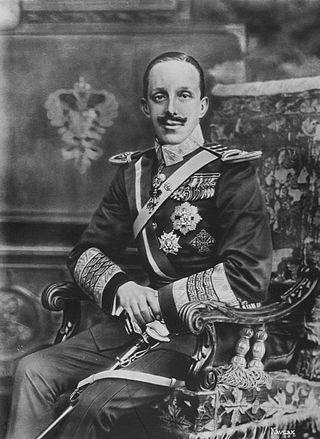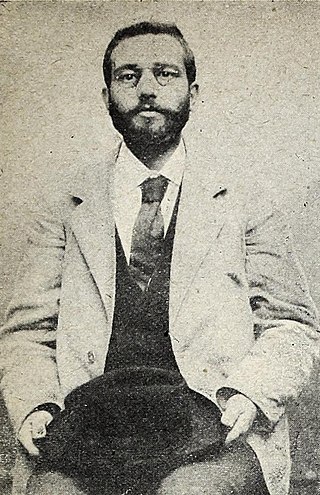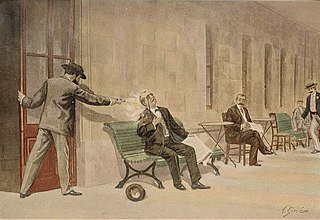Contents
This article needs additional citations for verification .(May 2016) |
| |||||
| Decades: | |||||
|---|---|---|---|---|---|
| See also: | Other events of 1897 List of years in Spain | ||||
Events from the year 1897 in Spain .
This article needs additional citations for verification .(May 2016) |
| |||||
| Decades: | |||||
|---|---|---|---|---|---|
| See also: | Other events of 1897 List of years in Spain | ||||
Events from the year 1897 in Spain .

Alfonso XII, also known as El Pacificador, was King of Spain from 29 December 1874 to his death in 1885.

Alfonso XIII, also known as El Africano or the African due to his Africanist views, was King of Spain from his birth until 14 April 1931, when the Second Spanish Republic was proclaimed. He became a monarch at birth as his father, Alfonso XII, had died the previous year. Alfonso's mother, Maria Christina of Austria, served as regent until he assumed full powers on his sixteenth birthday in 1902.

Michele Angiolillo Lombardi was an Italian anarchist, born in Foggia, Italy. He assassinated Spanish Prime Minister Antonio Cánovas del Castillo in 1897 and was captured and executed by Spanish authorities in the same year.

Antonio Cánovas del Castillo was a Spanish politician and historian known principally for serving six terms as prime minister and his overarching role as "architect" of the regime that ensued with the 1874 restoration of the Bourbon monarchy. He was assassinated by Italian anarchist Michele Angiolillo.

The Restoration or Bourbon Restoration was the period in Spanish history between the First Spanish Republic and the Second Spanish Republic from 1874 to 1931. It began on 29 December 1874, after a coup d'état by General Arsenio Martínez Campos ended the First Spanish Republic and restored the monarchy under Alfonso XII, and ended on 14 April 1931 with the proclamation of the Second Spanish Republic.

Francisco Silvela y Le Vielleuze was a Spanish politician who became Prime Minister of Spain on 3 May 1899, succeeding Práxedes Mateo Sagasta. He served in this capacity until 22 October 1900. Silvela also served a second term from 6 December 1902 to 20 July 1903, in which he succeeded another one of Práxedes Mateo Sagasta's many separate terms as prime minister.

Marcelo Azcárraga Palmero was a Spanish soldier-politician and Prime Minister of Spain following the restoration of the Spanish monarchy. He served as Prime Minister in 1897, 1900–1901, and 1904–1905. Azcárraga was the only Spanish Prime Minister of part Insulares, specifically Spanish Filipino, descent.

The Pantheon of Illustrious Men is a royal site in Madrid, under the administration of the Patrimonio Nacional. It was designed by Spanish architect Fernando Arbós y Tremanti, and is located in Basilica of Nuestra Señora de Atocha in the Retiro section of Madrid.
The Liberal Conservative Party, also known more simply as the Conservative Party, was a Spanish political party founded in 1876 by Antonio Cánovas del Castillo.

Alejandro Mon y Menéndez was a Spanish politician and jurist who was prime minister of Spain in 1864, during the reign of Queen Isabella II.

The 1898 Spanish general election was held on Sunday, 27 March and on Sunday, 10 April 1898, to elect the 8th Cortes of the Kingdom of Spain in the Restoration period. All 445 seats in the Congress of Deputies were up for election, as well as 180 of 360 seats in the Senate.
Antonio Castillo or Tony Castillo may refer to:
Events in the year 1879 in Spain.
Events in the year 1881 in Spain.
Events in the year 1884 in Spain.

Italian anarchist Michele Angiolillo assassinated Spanish Prime Minister Antonio Cánovas del Castillo on 8 August 1897, in Gipuzkoa. The head of government had been vacationing in the Santa Águeda spa. The assassin was immediately arrested, tried, and executed. He justified the murder as revenge for torture during the Montjuic trial.

Antonio Cánovas del Castillo y Vallejo, better known as Kaulak, was a Spanish photographer, art critic, editor and amateur painter. His uncle was prime minister Antonio Cánovas del Castillo, assassinated in 1897 by an anarchist, hence his use of a pseudonym; the meaning of which is unexplained, although the word appears to be of Basque origin.